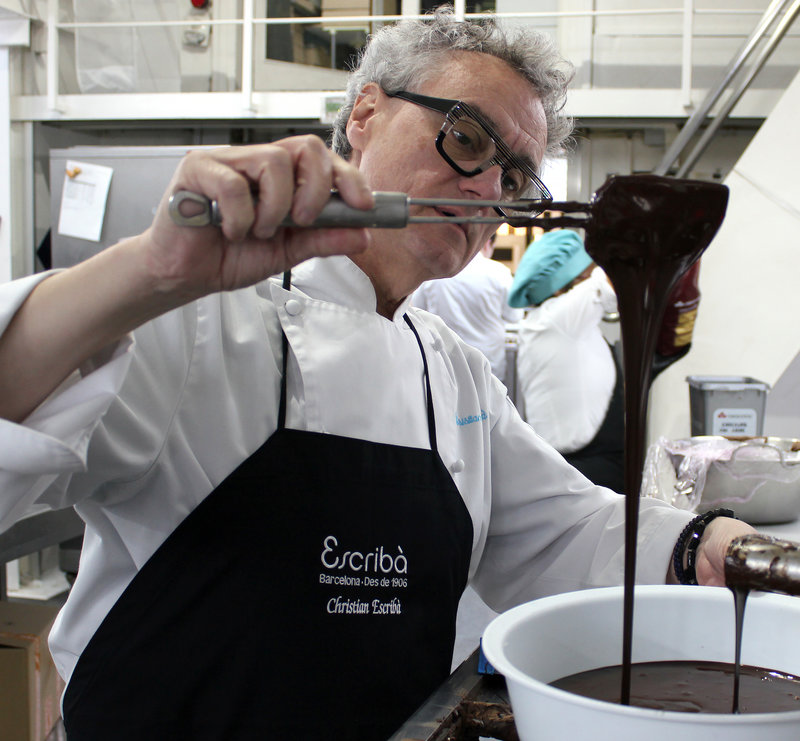At the age of 56, Christian continues to defy gravity to realise his dreams and the dreams of others “I like to work with chocolate because it has two faces: one would be related to taste, and the other would be creative”
“We have a department dedicated to what we call artistic chocolate” “At Escribá we like a chocolate that is about 70% pure cocoa”
If his father, Antoni Escribà, went down in history as the Magician of Chocolate, then Christian Escribà could undoubtedly be considered the Peter Pan of pastry making, the child who does not want to grow up, and someone who has managed to develop a limitless creative capacity that has opened doors around the world. His pastry shop is a factory for creating emotions. Genes do not lie and the imagination is infinite. No project is too extravagant for him: from a life-size chocolate Ferrari to the iconic six-metre tall Tous dog covered in more than 30,000 individual chocolates, a Millennium Falcon from Star Wars, and birthday cakes that explode or have dancers jumping out of them. It is pastry making turned into a show, and it comes from the imagination of a child who does not want to grow up. Today, at the age of 56, he continues to defy gravity to realise his dreams and the dreams of others. In a few days, he begins shooting a new pastry competition for Netflix in Paris. He simply does not stop.
What is chocolate to you?
It’s one of the important elements in pastry making, but I wouldn’t say it’s the best. I like to work with chocolate because it has two faces: one would be related to taste, and the other would be creative, which in Catalonia is represented by the mona de pasqua (the traditional Easter cake with a chocolate sculpture on top). For some eight years now, if you travel you’ll see them all over the world. And this is a one hundred per cent Catalan product, but we don’t claim enough credit for it. I don’t even think the French, Belgians and Italians, who know very well how to promote their own products, know that it’s a tradition from Catalonia. What’s more, they haven’t even shown any interest in knowing where this tradition comes from. We have to acknowledge that we haven’t known how to do that, and still have a lot of work to do in that respect...
But they make mones at your cake shops all year round...
Yes, but for a reason: chocolate allows us to make edible sculptures and more and more people like to give them on special dates or celebrations, especially personalised ones. That’s why we have a department dedicated exclusively to working on what we call artistic chocolate. There’s nothing we can’t make, from figures to miniature copies of things. Anything you can imagine we make real.
So this is one of your main lines of business?
You could say so, yes. We have two sections dedicated to work on the most creative and personalised part of pastry making: the chocolate team and the fondant team. These are the artists of the company, and their work is almost always commissioned because this type of pastry is always made to celebrate something special, be it an anniversary, a company party, a wedding, a goodbye or a welcome.
What’s the most bizarre order you’ve ever had?
Uff! I don’t know, but one comes to mind where we built the world’s largest chocolate waterfall, 8.5 metres high and 2 tonnes of chocolate, in Singapore.
What’s the biggest challenge when making a large figure out of chocolate?
The most delicate part is transportation, because chocolate is very fragile and if you aren’t very careful the disaster can be as big as, or bigger, than the figure itself... But with these huge figures, we transport them in pieces and assemble them at the place where they are to be displayed, and we often get help from engineers. We can’t take risks.
Of all the types of chocolate on the market, which do you prefer to work with?
We work with the Chocovic company, who make a special type of chocolate for us. Chocolate is like wine: even though we try to ensure Escribà chocolate has a special taste, each year it can change because it depends on the cocoa it’s made with, and that can vary according to the weather conditions where it’s from, the drying and roasting processes... The specialists at Chocovic make a blend from different types of cocoa, and know that at Escribá we like a certain type of chocolate, which is about 70% pure cocoa. That’s the best chocolate to work with in our workshop. Personally, I don’t like chocolate that is 90% cocoa, in fact I think it’s snobbish because you can’t actually eat it.
How and when do you recommend eating chocolate?
Many people think the best way to eat it is to just bite into it, and that’s not true. The best way is to break a piece with your fingers, put it in your mouth, close your eyes and let the piece melt a bit like a sweet. It’s worth concentrating on that. Even if we only dedicate two minutes a day to savouring a piece of chocolate we are giving ourselves over to a pleasure that helps us to be happy.
Are organic chocolates also a snobbish invention?
I have yet to taste a good one. It’s worth paying attention to what they’re trying to sell you because they can use the excuse that it’s organic just to sell a less elaborated chocolate that contains unacceptable elements.
What’s the secret to making good drinking chocolate?
Milk, pure cocoa, some icing sugar and a little bit of thickener. There’s no more to it than that.
interview

